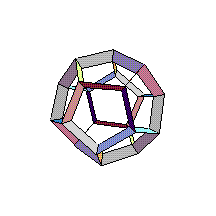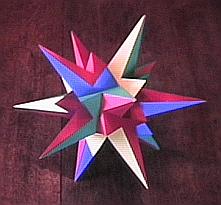Allgemeines
Polyedergarten
Ulrich Mikloweit - polyart@cityweb.de
Eine umfangreiche Sammlung sehr schöner Polyeder-Modelle. Alle
Polyeder sind aus Schreibmaschinenpapier angefertigt. Die Größe
beträgt je nach Modell zwischen etwa 7 bis etwa 30 cm Durchmesser.
Der Aufbau erfolgt schichtweise von innen nach außen. Die
Einzelteile (bis zu mehr als 1500 bei w85) wurden mit Messern und
Scheren ausgeschnitten und mit Klebstoff zusammengesetzt. Zusätzliche
Links zu weiteren interessanten Polyeder-Seiten.
http://www.polyedergarten.de/
 From
Fibonacci to the Platonic Solids From
Fibonacci to the Platonic Solids
Ted Courant
This
article introduces several related topics. First, we introduce
the Fibonacci numbers.
Second,we
introduce the Golden ratio, sometimes called the divine
proportion. The Golden ratio is related to Fibonacci numbers,
but is better known for its aesthetic qualities, and its role
in art and classical Greek architecture.
Third, we
introduce the five platonic solids, the two most complex of
which--the dodecahedron and its dual, the icosahedron--have
deep connections to the Golden ratio.
Finally, a
special method for constructing these solids is developed. We
discuss certain topological aspects of the sphere and torus,
and investigate some facts which allow us to analyze the
platonic solids in a way which will help us devise their
constructions.
http://www.klingenstein.org/Additional_Resources/projects/2000/courant/courant.html
Virtual
Polyhedra
The Encyclopedia of Polyhedra
George W. Hart - george@georgehart.com
Welcome to this collection of thousands of virtual reality
polyhedra for you to explore. I hope you enjoy playing with
them as much as I enjoyed making them. There are hundreds here
which have never been illustrated in any previous publication.
I believe the
best way to learn about polyhedra is to make your own paper
models or other
models. The second best is to play with a set
someone else has made. You can do that here because you can
look at, move, and spin these models which I have made for you.
And in one respect, virtual models have an advantage: you can
travel inside them to gain a perspective not possible in paper
models. After exploring my virtual models, I hope you choose
to make some of your own paper models.
http://www.georgehart.com/virtual-polyhedra/vp.html
Constructing
Platonic Solids in the Classroom
This page describes how to construct Platonic solids
out of toothpicks and gumdrops. Concepts: symmetry, crystal
structure.
The five
Platonic solids are the tetrahedron, the cube, the octahedron,
the dodecahedron, and the icosahedron. Their faces are regular
polygons. These solids are perfectly symmetrical in that each
face of a solid is identical to every other face of the solid,
each vertex is identical to every other vertex, and each edge
is identical to every other edge.
Each Platonic
solid has a dual: a solid whose vertices correspond to the
faces, and faces to the vertics. The dual of the cube is the
octahedron. The dual of the dodecahedron is the icosahedron.
The tetrahedron is its own dual.
There are 13
slightly less symmetrical solids called the Archimedean
solids. The faces of these solids are regular polygons,
their edges have the same length, and their vertices are
identical. Their faces, however, are not identical. An
Archimedean solid may have two or three different polygons as
faces.
http://krunk1.xmission.com/~dparker/mathpage/platonic.html
|




